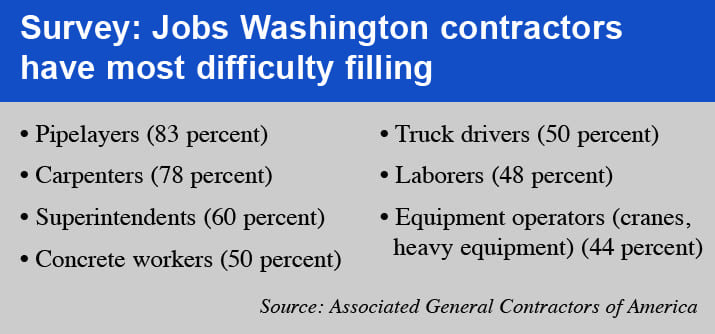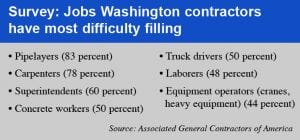
Home » Building industry feeling pinch of qualified workers
Building industry feeling pinch of qualified workers

December 15, 2016
A drive through the Tri-Cities will show you there’s plenty of construction going on, from new apartment complexes and schools to warehouses and office buildings.
But there’s a shortage of something that might not be as apparent: workers.
That’s according to a recent industry-wide survey from the Arlington, Virginia-based Associated General Contractors of America.
“Few firms across the country have been immune from growing labor shortages in the construction industry,” said Stephen Sandherr, CEO for Associated General Contractors, in a release. “The sad fact is too few students are being exposed to construction careers or provided with the basic skills needed to prepare for such a career path.”
Construction employment declined or was stagnant in a third of metro areas across the country between October 2015 and October 2016 amid diminishing public-sector investments in infrastructure and other civil works, according to a recent analysis of federal employment data by AGC.
Of the 1,358 survey respondents, 86 percent said they are having difficulty filling hourly craft or salaried professional positions.
Nationwide, 79 percent of responding firms are having a hard time filling one or more of the 21 hourly craft professional positions, particularly carpenters (73 percent of firms that employ carpenters report difficulty), sheet metal installers (65 percent) and concrete workers (63 percent).
 More than 50 percent of firms are having a hard time filling salaried professional positions, especially project managers/supervisors (listed by 55 percent of firms that employ them), estimators (43 percent) and engineers (34 percent), noted AGC’s chief economist, Ken Simonson.
More than 50 percent of firms are having a hard time filling salaried professional positions, especially project managers/supervisors (listed by 55 percent of firms that employ them), estimators (43 percent) and engineers (34 percent), noted AGC’s chief economist, Ken Simonson.
In Washington state, 70 percent said they have difficulty filling hourly craft positions, with the positions most difficult to fill listed as pipelayers (83 percent); carpenters (78 percent); superintendents (60 percent); concrete workers (50 percent); truck drivers (50 percent); laborers (48 percent); and heavy equipment operators (44 percent).
Statewide, the most difficult salaried slots to fill are project managers/supervisors (56 percent); engineers (47 percent); and estimating personnel (30 percent).
More than 60 percent of Washington contractors expect it will be difficult to hire hourly craft workers in the next year, according to the survey. And that’s despite more than 40 percent saying their firm increased base pay rates.
The Building Industry Association of Washington told the Tri-Cities Area Journal of Business the agency is making it a priority to work with legislators, businesses and schools to find solutions.
Real Estate & Construction
KEYWORDS december 2016




